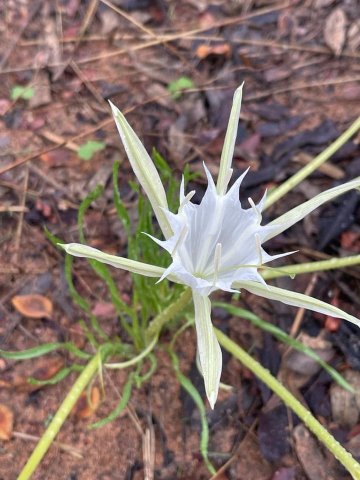Pancratium tenuifolium spreading tepals

Author: Ivan Lätti
Photographer: Louis van der Merwe
Pancratium tenuifolium, sometimes called the one-day lily, annually grows three to eight leaves from the deep-seated bulb when the summer rains (and maybe the heat) prompt it. The leaves are up to 35 cm long while only 7 mm wide.
The specific name, tenuifolium, is derived from the Latin words tenuo meaning to make thin or attenuate and folium meaning leaf, referring to the leaf-shape.
In picture there must have developed a cluster of bulbs over the years on this site, as the linear, spirally twisted leaves are more in number, and several flower peduncles or scapes arise from them; only one showing its flower in the photo.
The scapes of this plant are solid, not hollow as in certain other bulbous plants. Bulbous monocots, the many lilies including the Amaryllidaceae family of which the Pancratium genus forms part, are mostly admired for their dominant tepals or perianth segments of their flowers.
Here the filament cup surpasses the perianth: The six narrowly lance-shaped and acutely pointed tepals do spread widest and creamy around the rest of the flower but are a bit sepal-like. It is the whiter filament cup above them that catches the eye as the centre of floral beauty.
Pollinators that may lack an aesthetic sense are also right when they favour the cup over the spreading spokes, as the pollen is found in the anthers hanging over the cup.
The short-lived flowers, pollinated by (at least) long-tongued hawkmoths, bud in the late afternoon and open explosively during the early evening. They exude a sweet fragrance during the night and fade rapidly by midmorning on the following day. No wonder the plant earned the Afrikaans name of aandblommetjie (little evening flower).
The inferior ovary (positioned below the calyx, in this case below the perianth), swells notably within two days from pollination and the prompt withering of the corolla.
The fruit is a globose to obovoid, locular capsule. The glossy black seeds, about 4 mm in diameter, ripen within six weeks (Duncan, et al, 2016; Leistner, (Ed.), 2000; JSTOR; iNaturalist; www.zimbabweflora.co.zw).

